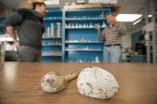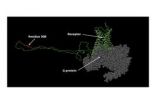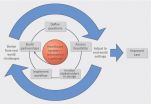Typhoid Mary, not typhoid mouse
2014-12-04
The bacterium Salmonella Typhi causes typhoid fever in humans, but leaves other mammals unaffected. Researchers at University of California, San Diego and Yale University Schools of Medicine now offer one explanation -- CMAH, an enzyme that humans lack. Without this enzyme, a toxin deployed by the bacteria is much better able to bind and enter human cells, making us sick. The study is published in the Dec. 4 issue of Cell.
In most mammals (including our closest evolutionary cousins, the great apes), the CMAH enzyme reconfigures the sugar molecules found on these animals' ...
Obesity and hypertension
2014-12-04
The link between obesity and cardiovascular diseases is well acknowledged. Being obese or overweight is a major risk factor for the development of elevated blood pressure, and cardiovascular diseases. But it has net been known how obesity increases the risk of high blood pressure, making it difficult to develop evidence based therapies for obesity, hypertension and heart disease.
In a ground-breaking study, published today in the prestigious journal, Cell (embargo midday EST), researchers from Monash University in Australia, Warwick, Cambridge in the UK and several American ...
'Satiety hormone' leptin links obesity to high blood pressure
2014-12-04
Leptin, a hormone that regulates the amount of fat stored in the body, also drives the increase in blood pressure that occurs with weight gain, according to researchers from Monash University and the University of Cambridge.
Being obese or overweight is a major risk factor for the development of high blood pressure and cardiovascular disease. Whilst a number of factors may be involved, the precise explanation for the link between these two conditions has been unclear.
In a study published today in the journal Cell, a research team led by Professor Michael Cowley, ...
People with mental illness more likely to be tested for HIV, Penn Medicine study finds
2014-12-04
PHILADELPHIA--People with mental illness are more likely to have been tested for HIV than those without mental illness, according to a new study from a team of researchers at Penn Medicine and the U.S. Centers for Disease Control and Prevention (CDC) published online this week in AIDS Patient Care and STDs. The researchers also found that the most seriously ill - those with schizophrenia and bipolar disease - had the highest rate of HIV testing.
The study assessed nationally representative data from 21,785 adult respondents from the 2007 National Health Interview Survey ...
A poisonous cure
2014-12-04
EAST LANSING, Mich. - Take two poisonous mushrooms, and call me in the morning. While no doctor would ever write this prescription, toxic fungi may hold the secrets to tackling deadly diseases.
A team of Michigan State University scientists has discovered an enzyme that is the key to the lethal potency of poisonous mushrooms. The results, published in the current issue of the journal Chemistry and Biology, reveal the enzyme's ability to create the mushroom's molecules that harbor missile-like proficiency in attacking and annihilating a single vulnerable target in the ...
Research: NFL athletes are seeking unproven stem cell treatments
2014-12-04
Some National Football League (NFL) players have been seeking out unproven stem cell therapies to help accelerate recoveries from injuries, according to a new paper from Rice University's Baker Institute for Public Policy. While most players seem to receive treatment within the United States, several have traveled abroad for therapies unavailable domestically and may be unaware of the risks involved, the paper found.
The paper is published in the 2014 World Stem Cell Report, which is a special supplement to the journal Stem Cells and Development and is the official publication ...
Kent State researchers find more smartphone play equals less fun during leisure
2014-12-04
Today's smartphones are designed to entertain and are increasingly marketed to young adults as leisure devices. Not surprisingly, research suggests that young adults most often use their phones for entertainment purposes rather than for school or work.
With this in mind, three Kent State University researchers, Andrew Lepp, Ph.D., Jacob Barkley, Ph.D. and Jian Li, Ph.D., and a Kent State graduate student, Saba Salehi-Esfahani, surveyed a random sample of 454 college students to examine how different types of cell phone users experience daily leisure.
The trio from ...
Genome sequencing for newborns: What do new parents think?
2014-12-04
Boston, MA - A study published this week in Genetics in Medicine is the first to explore new parents' attitudes toward newborn genomic testing. The findings suggest that if newborn genomic testing becomes available, there would be robust interest among new parents, regardless of their demographic background.
The study, led by researchers at Brigham and Women's Hospital (BWH) and Boston Children's Hospital, found that the majority of parents surveyed were interested in newborn genomic testing.
As next-generation whole-exome and genome sequencing is integrated into clinical ...
Two in 10 adults seriously considered suicide in 2013, CAMH survey shows
2014-12-04
TORONTO, Dec. 4, 2014 - Results from an ongoing survey conducted by the Centre for Addiction and Mental Health (CAMH) show that 2.2 per cent of adults --or over 230,000 people in Ontario, Canada -- seriously contemplated suicide in the last year. The 2013 edition of the CAMH Monitor, released today, included questions about suicidal ideation for the first time in the survey's history.
"Suicide is a major public health issue, and these data confirm that large numbers of Ontario adults report having suicidal thoughts," said Dr. Hayley Hamilton, CAMH scientist and co-principal ...
Insecticides foster 'toxic' slugs, reduce crop yields
2014-12-04
Insecticides aimed at controlling early-season crop pests, such as soil-dwelling grubs and maggots, can increase slug populations, thus reducing crop yields, according to researchers at Penn State and the University of South Florida.
"Neonicotinoids are the most widely used insecticides in the world," said Margaret Douglas, graduate student in entomology, Penn State. "Seed applications of neonicotinoids are often viewed as cheap insurance against pest problems, but our results suggest that they can sometimes worsen pest problems and should be used with care."
According ...
Higher birth weight indicates better performance in school
2014-12-04
GAINESVILLE, Fla. -- It's no secret that low-birth-weight babies face significantly greater risks for certain health problems early on, such as respiratory distress or infection. Now, a new study from researchers at the University of Florida and Northwestern University shows that lower weights at birth also have an adverse effect on children's performance in school, which is likely due to the early health struggles small babies often face.
Using a unique set of data that matched birth and school records from 1.6 million children born in Florida between 1992 and 2002, ...
Nalmefene for alcohol dependence: Added benefit not proven
2014-12-04
Nalmefene (trade name Selincro) has been approved since February 2013 for people with alcohol dependence who currently drink a lot of alcohol, but who do not have physical withdrawal symptoms and who do not require immediate detoxification. The German Institute for Quality and Efficiency in Health Care (IQWiG) examined in a dossier assessment whether the drug offers an added benefit over the appropriate comparator therapy in this patient group.
According to the findings, such an added benefit is not proven: In its dossier, the drug manufacturer only presented data for ...
AU professor constructs model of receptor protein linked to human growth
2014-12-04
A study published in the New England Journal of Medicine reveals the role of a receptor protein derived from a gene that has been linked to human growth. Co-author Stefano Costanzi, Ph.D., an assistant professor of biochemistry at American University, developed the three-dimensional computer model of the receptor that appears in the study.
"As the study reveals the receptor's role in growth, it may ultimately lead to the development of drugs to treat those affected with conditions that alter growth, such as gigantism or dwarfism," Costanzi said. "The construction of the ...
Pulsars with black holes could hold the 'holy grail' of gravity
2014-12-04
The intermittent light emitted by pulsars, the most precise timekeepers in the universe, allows scientists to verify Einstein's theory of relativity, especially when these objects are paired up with another neutron star or white dwarf that interferes with their gravity. However, this theory could be analysed much more effectively if a pulsar with a black hole were found, except in two particular cases, according to researchers from Spain and India.
Pulsars are very dense neutron stars that are the size of a city (their radius approaches ten kilometres), which, like lighthouses ...
UT Dallas engineer applies robot control theory to improve prosthetic legs
2014-12-04
A University of Texas at Dallas professor applied robot control theory to enable powered prosthetics to dynamically respond to the wearer's environment and help amputees walk.
In research available online and in an upcoming print issue of IEEE Transactions on Robotics, wearers of the robotic leg could walk on a moving treadmill almost as fast as an able-bodied person.
"We borrowed from robot control theory to create a simple, effective new way to analyze the human gait cycle," said Dr. Robert Gregg, a faculty member in the Erik Jonsson School of Engineering and Computer ...
Recommendations against mother-infant bedsharing interfere with breastfeeding
2014-12-04
New Rochelle, NY, December 4, 2014--Recommendations by physician groups to avoid bedsharing among mothers and their babies are intended to reduce sleep-related infant deaths. But evidence suggests that the risks of bedsharing have been over-emphasized, advice never to bedshare is unrealistic, and avoiding bedsharing may interfere with breastfeeding, according to an article in Breastfeeding Medicine, the official journal of the Academy of Breastfeeding Medicine published by Mary Ann Liebert, Inc., publishers. The article is available free on the Breastfeeding Medicine website ...
Living African group discovered to be the most populous humans over the last 150,000 years
2014-12-04
New genetic research reveals that a small group of hunger-gatherers now living in Southern Africa once was so large that it comprised the majority of living humans during most of the past 150,000 years. Only during the last 22,000 years have the other African ethnicities, including the ones giving rise to Europeans and Asians, become vastly most numerous. Now the Khoisan (who sometimes call themselves Bushmen) number about 100,000 individuals, while the rest of humanity numbers 7 billion. Their lives and ways have remained unaltered for hundreds of generations, with only ...
How to create and sustain clinical-research partnerships
2014-12-04
SEATTLE--Pragmatic clinical trials--real-life tests done in real-world settings--are increasingly important for answering pressing questions about how best to deliver health care. But these pragmatic trials require close collaboration between two professional groups who often have contrasting styles. One group is researchers, who follow structure like classical musicians. The other is and health care providers and administrators, who may need to improvise like jazz musicians. How in the world can such disparate players make beautiful music together?
"The key is not just ...
Medical schools have ethical obligation to accept undocumented immigrants
2014-12-04
MAYWOOD, Il. - Medical schools have an ethical obligation to change admission policies in order to accept applications from undocumented immigrants known as Dreamers, according to an article in the December, 2014 issue of the journal Academic Medicine.
Not allowing Dreamers to apply to medical school "represents a kind of unjustified discrimination and violates the basic ethical principle of the equality of human beings," write co-authors Mark G. Kuczewski, PhD and Linda Brubaker, MD, MS of Loyola University Chicago Stritch of Medicine. Academic Medicine is the journal ...
Research could improve nuclear power plant safety -- and stop your kettle furring up
2014-12-04
Taking inspiration from nature, researchers have created a versatile model to predict how stalagmite-like structures form in nuclear processing plants - as well as how lime scale builds up in kettles.
"It's a wonderful example of how complex mathematical models can have everyday applications," said Dr Duncan Borman, from the School of Civil Engineering at the University of Leeds, a co-author of the study.
The main aim of the research, which is published in print today in the journal Computers & Chemical Engineering, is to reduce the number of potentially harmful manual ...
NTU leads global research to uncover one of mankind's most ancient lineages
2014-12-04
Scientists at Nanyang Technological University (NTU Singapore) and Penn State University in the United States have successfully discovered one of modern human's ancient lineages through the sequencing of genes.
World-renowned geneticist from NTU, Professor Stephan Christoph Schuster, who led an international research team from Singapore, United States and Brazil, said this is the first time that the history of mankind populations has been analysed and matched to Earth's climatic conditions over the last 200,000 years.
Their breakthrough findings are published today ...
Chinese scientists create new global wetland suitability map
2014-12-04
Wetlands are among the most productive ecosystems on Earth. Yet with increasing urbanization and agricultural expansion, wetlands around the globe are in danger. Better mapping of wetlands worldwide will help in their protection.
But compiling globe-spanning maps of wetlands is impeded by the dramatic diversity and evolving dynamics of wetlands, and by myriad difficulties in doing field work.
To develop a better model, Gong Peng and other scientists at the State Key Laboratory of Remote Sensing Science, Chinese Academy of Sciences, in Beijing incorporated hydrologic, ...
Natural substance in red wine has an anti-inflammatory effect in cardiovascular diseases
2014-12-04
A natural substance present in red wine, resveratrol, inhibits the formation of inflammatory factors that trigger cardiovascular diseases. This has been established by a research team at the Department of Pharmacology of the University Medical Center of Johannes Gutenberg University of Mainz (JGU) working in collaboration with researchers of the Friedrich Schiller University in Jena and the University of Vienna. Their results have recently been published in the scientific journal Nucleic Acids Research.
Despite the fact that they eat more fatty foods, the French tend ...
Don't worry, be happy: Just go to bed earlier
2014-12-04
When you go to bed, and how long you sleep at a time, might actually make it difficult for you to stop worrying. So say Jacob Nota and Meredith Coles of Binghamton University in the US, who found that people who sleep for shorter periods of time and go to bed very late at night are often overwhelmed with more negative thoughts than those who keep more regular sleeping hours. The findings appear in Springer's journal Cognitive Therapy and Research.
People are said to have repetitive negative thinking when they have bothersome pessimistic thoughts that seem to repeat in ...
Electron pairs on demand
2014-12-04
This news release is available in German.
In quantum optics, generating entangled and spatially separated photon pairs (e.g. for quantum cryptography) is already a reality. So far, it has, however, not been possible to demonstrate an analogous generation and spatial separation of entangled electron pairs in solids. Physicists from Leibniz University Hannover and from the Physikalisch-Technische Bundesanstalt (PTB) have now taken a decisive step in this direction. They have demonstrated for the first time the on-demand emission of electron pairs from a semiconductor ...
[1] ... [3028]
[3029]
[3030]
[3031]
[3032]
[3033]
[3034]
[3035]
3036
[3037]
[3038]
[3039]
[3040]
[3041]
[3042]
[3043]
[3044]
... [8704]
Press-News.org - Free Press Release Distribution service.












